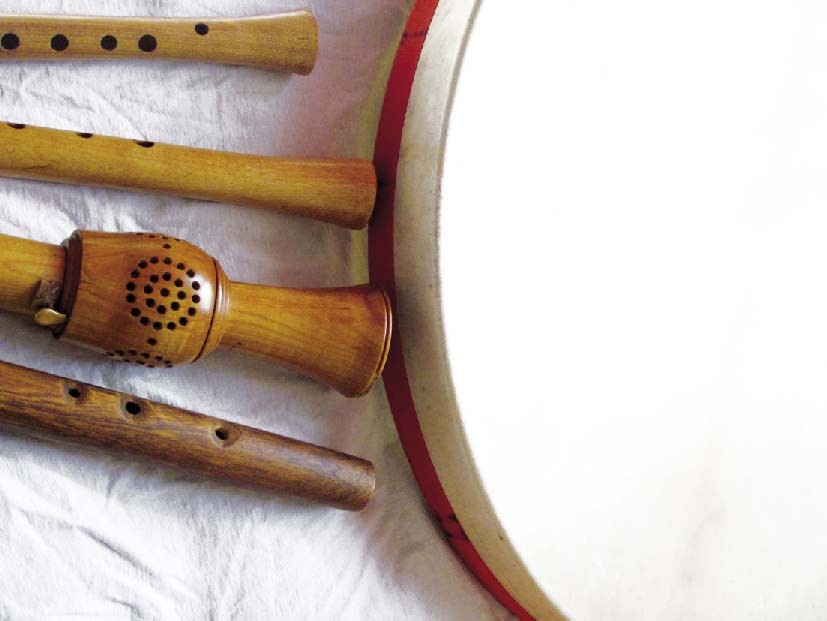
evo: castellano • English
Songsurfer 2012
1. Be m’han pedut l’ai [6:38]
Bernat de VENTADORN, 12th C. | Efrén López
2. De la iensor [6:38]
Berenguer de PALAU, 12th C. | Efrén López
3. Per troppo fede [4:53]
Anonymous, 14th C. | Efrén López
4. Pour longue attente [6:57]
Anonymous contrafactum of a song by Bernat de VENTADORN, 12th C. | Efrén López
5. Istampitta Isabella [6:41]
Anonymous, 14th C. | Efrén López
6. Lanquan li jorn [7:17] LLJ
Jaufre RUDEL, 12th C.
7. Tant m’abelis l’amorós pessamens [4:11]
Folquet de MARSELHA, 12th C. | Efrén López
8. Comment que, per l’élogiance [3:00]
Jehan de LESCUREL, 13th C.
9. Bel m’es qu’ieu chant e coindei [4:30]
Raimon de MIRAVAL, 12th-13th C.
10. Domna por vos ay chausida • Estampie royale [5:24]
Anonymous, 13th C. • Anonymous, 14th C.
11. Bona dona [3:32]
Berenguer de PALAU, 12th C. | Efrén López
12. Istampita ghaetta [5:32]
Anonymous, 14th C.
13. Ondas do mar de Vigo [6:12] ca I
Martin CÓDAX, 12th C.
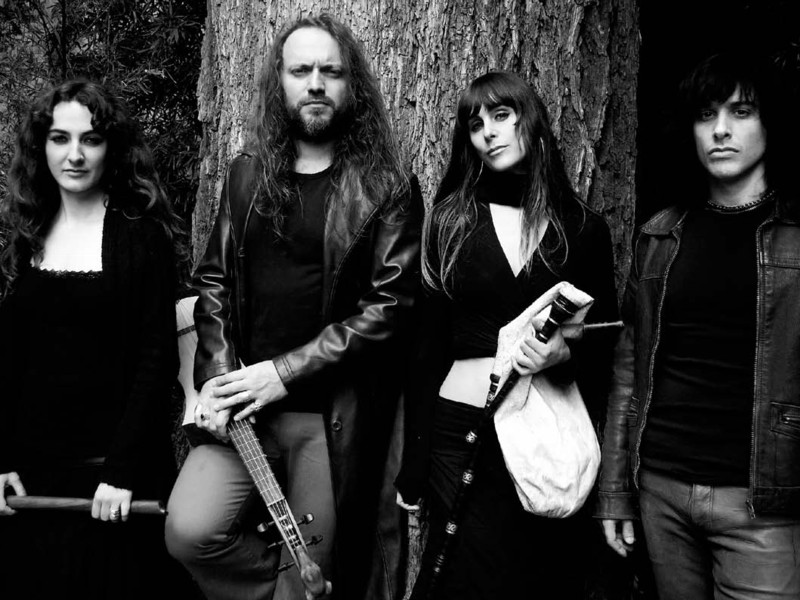
EVO
Efrén López
• Efrén López Sanz:
Hurdy gurdy, citole, bass citole, guittern, cistre, kopuz, oud, gothic harp, trompette marine, plucked psaltery, bowed psaltery, hammered psaltery, langeleik
• Miriam Encinas Laffitte: Recorder, frame drum
• Laia Puig Olives: Shawn, gaida, dolçaina, tsambouna, recorder, bagpipe
• Iván López Sanz: vocals
Guest musicians:
• Pau Marcos: vielle
• Pedram Khavarzamini: tombak
• Diego López Sanz: frame drum, davoul, darbuka, req, tamburello, tambourine, square frame drum from Peñaparda
• Aleix Tobias Sabater: drum from Calanda, frame drum, tambourine, reco reco, cymbals, metallic percussions, gongs
• Maria Laffitte Masjoan: bell (sample on “Bel m’es qu’ieu”)
Arranged, produced, mixed and mastered by Efrén López
Executive producer: Claus Altvater
© 2012 Songsurfer
1.
A canso about absence, in which the pain of unrequited love forces the
troubadour to leave his familiar surroundings. We have added an
instrumental section of our own composition to this magnificent piece,
which provides a counterpoint to the main melody in the third verse.
Iván López Sanz: vocals, backing vocals
In this, one of the oldest cansons of the Catalonian troubadours, we
hear of how the cold pride of a beloved domna causes great suffering
and leads to self-imposed exile. We have kept the original melody, but
have also added newly composed instrumental interludes in a canon
played by two recorders.
Iván López Sanz: vocals
Both the dangers and the great pleasures of love are once again the
central motif to this monodic Italian ballata, found in the Codice
Rossiniano 215 manuscript.
Iván López Sanz: vocals
This anonymous contrafactum of a canso by Bernat de Ventadorn shows an
example of a musical process typical of the medieval period. It
consists of using a well-known melody to intensify or change the
meaning of a given text.
Iván López Sanz: vocals
Preserved in the Codex London BLA 29987, and composed in 14th century
Italy, this is a dance featuring the istampitta, or “stamping of
the foot” on the strong beats. The dance had a clear symbolic
value in the game of courtly love, as well as providing an important
educational tool for refining the rules of courtly behaviour. Two
improvised sections on the double flute and tambourine precede the
original melody, to which we have added a harmonic accompaniment on the
vielle and the bass citole.
Miriam Encinas Laffitte: recorder, double recorder
Also known as the canso de lonh, this is the most famous canso by
Jaufré Rudel, and it has survived in no less than three musical
manuscripts. According to the mythical biography “Vida”,
which accompanies the lyrical compositions, Jaufré Rudel, prince
of Blaia, fell deeply in love with the Countess of Tripoli without ever
having laid eyes upon her, and so set out on a pilgrimage in order to
declare his love to her. He is said to have expired in her arms the
moment he laid eyes on her. The repetition of the word
“lonh” is a poetic device which compounds the sense of
longing for an idealised form of love and highlights the ineffability
of romantic sentiment.
Iván López Sanz: vocals
A song of love composed by Folquet de Marselha between 1180 and 1185.
Cited by Dante as an example of excellence in poetic-musical
construction, this canso praises the sweetness of a pure love which
brings both happiness and pleasure. In our efforts to arrange the
original transcript in a satisfactory time signature, we came across
this adaptation in 5/8 time which, although historically improbable,
impressed us with its force, and provided the perfect excuse to give
the piece a popular air with the davoul and the tsambouna.
Iván López Sanz: vocals
This instrumental version of a ballade by the trouèe Jehan de
Lescurel (ms París BN 146) reflects upon the world of lyrical
poetry in the old French of the 13th and 14th centuries, which
continued to promote chivalrous values.
Miriam Encinas Laffitte: recorders
This canso was composed in 1213 and dedicated to Pere II of Aragon. The
razo (introductory speech) to this song tells of the excommunication of
the Count of Tolosa and the subsequent loss of his lands. Within the
constraints of courtliness, Raimon de Miraval expresses his hope that
on the one hand, the world of chivalry be returned to its former state,
and on the other that he can continue to enjoy the courtly love of
Leonor, the wife of the Count. In bucolic surroundings Raimon de
Miraval sings of his love for this royal lady, paying homage to her beauty
and virtues.
Iván López Sanz: vocals, backing vocals
A promise to a lady of eternal love, unconditional surrender. We have
taken the liberty of recording this piece as we perform it live, with
the added French estampie royale dance to round off the troubadour-like
theme.
Iván López Sanz: vocals
This canso is a celebration of the excellence of a beloved domna, in
which the troubadour asks forgiveness from his lady for his inability
to keep his sentiments a secret. In what can be termed an experiment in
historical harmonisation we have added a duplum and a tenor to the
original monophonic melody, in a style which reigned supreme in Western
Europe of the 12th and 13th centuries.
Iván López Sanz: vocals
This piece and Isabella, the other istampitta included on this disc,
are the two dances taken from the Codex London BLA 29987 which were
mysteriously named after women. This compilation of music is of great
importance in the world of western musical history, as it provides the
earliest written evidence of exclusively instrumental pieces with no
accompanying text.
Efrén López Sanz: hurdy gurdies
This cantiga is preserved with six others in the Pergamino Vindel,
which is the only surviving manuscript with musical notation from this
Galician troubadour. The peculiarity of this lyrical composition in
Galician-Portuguese is that unlike the previous songs, this is a
declaration of love from a feminine point of view, with original
expressive characteristics. The voice is that of a domna lamenting the
absence of her friend and lover, who is in an unspecified location far
away. The love expressed in this cantiga de amigo remains unsatisfied
due to a forced separation. The sense of sadness and frustration is set
in coastal Galicia and the sea personifies the stormy mood of the
enamoured lady. This domna is not in fact an aristocratic lady of the
troubadour’s poetic world, but an earthly, passionate and pained
creature, expressing her feelings of love.
Iván López Sanz: vocals
Efrén López, Mohlos (Crete, Greece), december 2011.
• Recorded by Efrén López and Constantino López over several sessions:
· December 2010, March and July 2011 at the Primavera en el Atlas studios (Alhama de Murcia)
· September 2011 at the Ground studios in Cornellà del Terri.
· October 2011 at the El bolquer alegre studios in Riba-roja de Túria.
• Edited and mixed in November and December 2011 by Efrén
López at the Millenia studios in Valencia, Mohlos in Mohlos
(Crete, Greece), and during several train, car, underground, bus, boat and plane trips in the “Give me the cheapest laptop
you have - no, not the ‘most economical’ in sales-speak, but - I insist - the absolute cheapest” mobile studio
between October and December 2011.
• Mastered by Efrén López at Ping Pong Master (Valencia) in May of 2012.
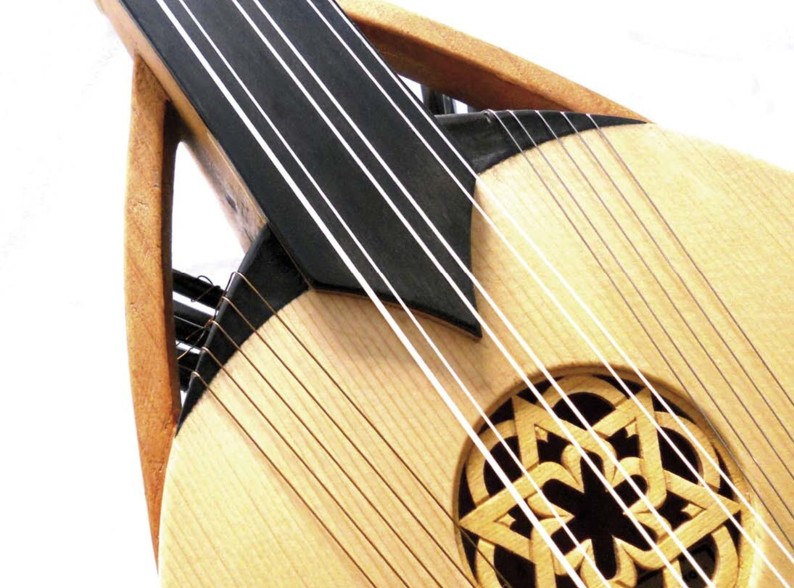
Be m’an perdut lai
(Bernat de Ventadorn, 12th C. / Efrén López)
Efrén López Sanz: plucked psaltery, bass citole, guittern, cistre
Diego López Sanz: darbuka, frame drums, tamburello, req, defi
2.
Uns senyors amb barba
(Efrén López)
De la iensor qu’om vey
(Berenguer de Palou, 12th C./ Efrén López)
Efrén López Sanz: kopuz
Laia Puig Olives: double recorder, shawn
Miriam Encinas Laffitte: recorder
Diego López Sanz: frame drums, tombak
Pau Marcos: vielles
3. Per troppo fede
(Anonymous, 14th C. / Efrén López)
Efrén López Sanz: hurdy gurdy, gothic harp, cistre
Laia Puig Olives: bagpipe
Miriam Encinas Laffitte: recorders
Diego López Sanz: tamburello, tambourine, square frame drum from Peñaparda
4.
És l’hàier
(Efrén López)
Pour longue atente de merci
(Anonymous contrafactum of a song by Bernat de Ventadorn, 12th C./ Efrén López)
Our version transposes the melody into the Lydian mode (F) and the
Mixolydian mode (G), and includes two new compositions for three shawns
which serve as an introduction and interlude respectively.
Efrén López Sanz: gothic harps, trompette marine, citole, bass citole
Laia Puig Olives: shawns
Pau Marcos: vielles
Aleix Tobias Sabater: drum from Calanda
5.
Istampitta Isabella
(Anonymous, 14th C.)
Efrén López Sanz: citole, bass citole
Pau Marcos: vielle
Aleix Tobias Sabater: tambourine, frame drum
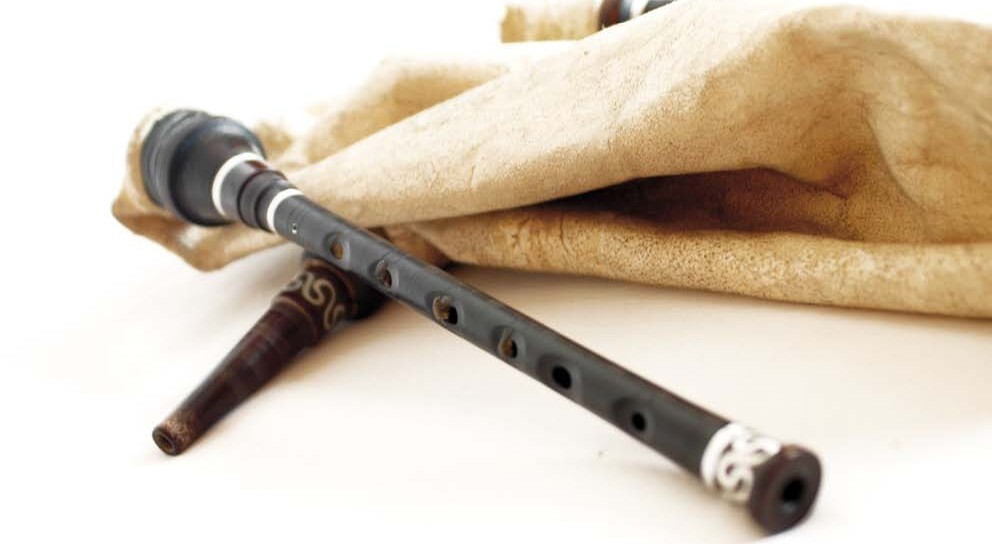
6.
Lanquan li jorn
(Jaufre Rudel, 12th C.)
Efrén López Sanz: hurdy gurdies, oud
7.
Tant m’abelis l’amoros pessamens
(Folquet de Marselha, 12th C. / Efrén López)
Efrén López Sanz: kopuz, hurdy gurdy
Laia Puig Olives: tsambouna
Diego López Sanz: davoul
8.
Comment que, per l’élogiance
(Jehan de Lescurel, 13th C.)
9.
Bel m’es qu’ieu chant e coindei
(Raimon de Miraval, 12th-13th C.)
Efrén López Sanz: hurdy gurdy, plucked psaltery, langeleik
Laia Puig Olives: gaida
Miriam Encinas Laffitte: recorders, frame drums
Pedram Khavarmanini: tombak
Maria Laffitte Masjoan: bell
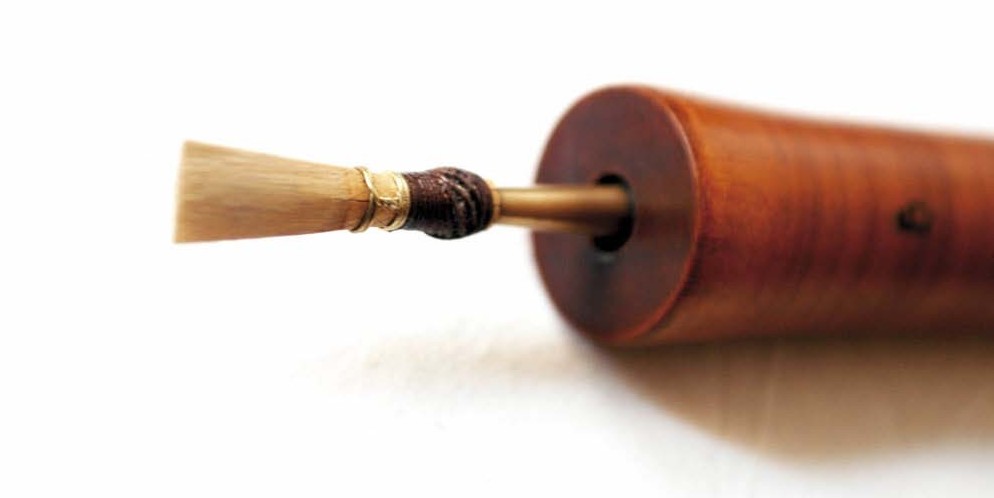
10.
Domna, por vos ay chausida
(Anonymous, 13th C.)
Estampie royale
(Anonymous, 14th C.)
Efrén López Sanz: hurdy gurdy, hammered psaltery
Laia Puig Olives: bagpipe
Miriam Encinas Laffitte: recorder
Diego López Sanz: square frame drum from Peñaparda, tambourine
11.
Bona dona
(Berenguer de Palou,12th C./ Efrén López)
Efrén López Sanz: guittern
Miriam Encinas Laffitte: recorders
Pau Marcos: vielle
12.
Istampitta Ghaetta
(Anonymous, 14th C.)
Laia Puig Olives: bagpipe
Miriam Encinas Laffitte: recorder.
Aleix Tobias Sabater: drum from Calanda, reco reco, cymbals, metallic percussion, gongs
15.
Ondas do mar de Vigo
(Martín Códax, 13th C.)
Efrén López Sanz: trompette marine, bowed psaltery, hurdy gurdy
Miriam Encinas Laffitte: recorder
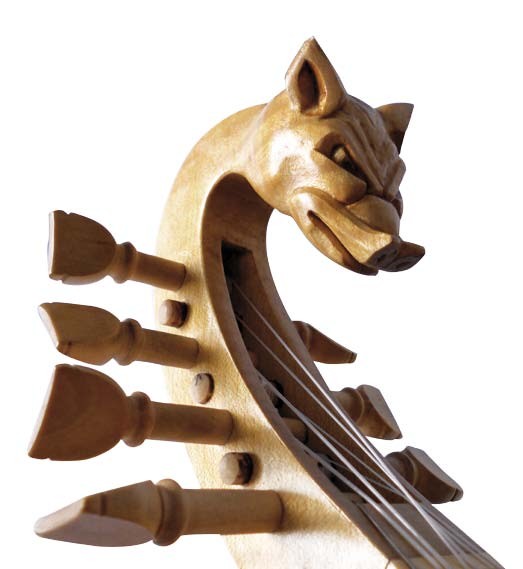
· Claus Altvater appeared whenever least expected and brought with them
copious amounts of ideas, has injected enthusiasm, initiative and
passion. The expertise he gained working with guitar virtuoso Al Di
Meola has propelled this project to completion.
· Constantino López has shown infinite patience and kept faith in
the project from the very start, offering his unconditional support to
the album and an extremely rare vocation to do things the way they
ought to be done.
· Nora Tigges answered our call for her valued assessment of both the texts themselves and out pronunciation of them.
· Juan José Robles provided his un-repayable hospitality time and again during the sessions at Alhama in Murcia.
· Paco Sánchez and María Enguix did the same in Valencia, as always with great affection and joy.
· For the zillionth time, Pasqual Brisa and Eva Ferrando came to our aid
in the final stages of the recording, making us feel completely at home
among the microphones, cables, nappies, crying babies, and aioli with
home-baked bread.
· An anonymous little star took the plunge and posed for the photo
session which Gisela M. once again took charge of for us, all the while
stoically putting up with our neophyte suggestions.
· Pau Marcos and his vielle had us listening with fresh ears to melodies that we had thought would never surprise us again.
· Diego López has become a worthy ambassador of his manisero
pedigree, taking over the studio with a whole range of drums which he
used to build authentic walls of percussion.
· We were privileged to have Pedram Khavarzamini in the studio, our jaws
constantly dropping at the number of subtleties that only he can draw
forth on the tombak.
· Aleix Tobias was like a kid in a toy store - as were we - with his
against-the-clock, sleepless, risky, crazy and yet somehow infinitely
wise percussion.
Most likely without him even realising it, the exorbitant enthusiasm
and altruism of our friend One played a major role in the realisation
of this project.
· Moncho Hernández, both in person and with his Volkswagen, has
been essential to transporting our instruments and our bods all over
the place.
· We have also received unconditional support from Cristóbal
Aixendri, Pau Puig, Antoni Segarra, Sara Parés, Dani Carbonell
and Marisa Falcó in conditioning and lending us double-reed wind
instruments.
· A fistful of luthiers/friends (Asier de Benito, Dimitris Rapakousios,
Stelios Petrakis, Vicent Ferrús, Sedo García, Javier
González, Juan Ruvira, Jorge Guzmán from Guzz Guitars,
Ralf Eickmeier, Marcelo Morillo, J. Eduardo Márquez...) have
made and/or conditioned many of the instruments that you can hear on
the album, and have lent us a hand with all the accessories.
· If everyone was just like Stelios Petrakis and his family (Zina,
Despina, Maria, Giannis, Manolis, Kathigitis, Maro, Nikos, Litsa,
Giorgos and grandmother Nafsika) we would find a million reasons to do
nothing more than mix albums in Crete and bask in their wonderful
affection.
· From Maria Laffitte, to whom this project is dedicated, we learnt some
of the songs you will hear and, above all else, to feel real love for
this music and its message, symbolism and mystery.
For all of which we are eternally grateful.
Photography: Gisela M (cover and band), Efrén López, Miriam Encinas and Pau Puig (instruments)
Evo logo: Iván López
Design: Belén Ballesteros
English translation: Lisa Jane Roberts
Texts correctors: Neus Olives (Catalan)
Pronunciation advisor: Nora Tigges
Texts: Maria Incoronata Colantuono and Efrén López
